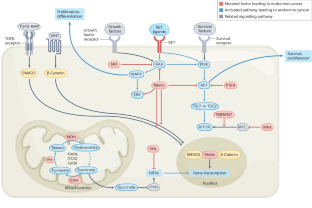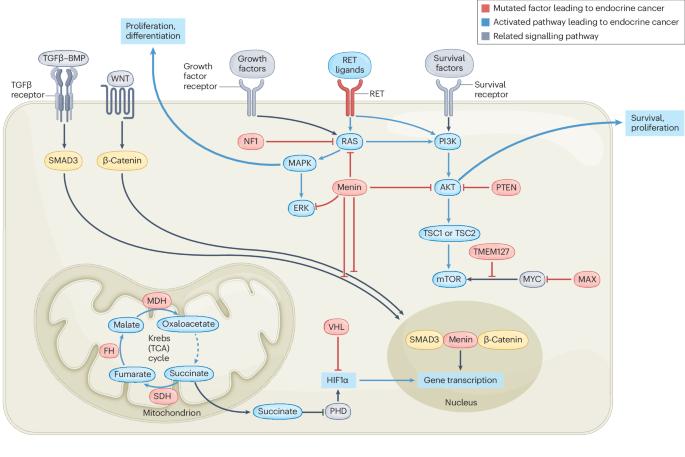内分泌肿瘤的循环非编码 RNA 生物标记物
IF 31
1区 医学
Q1 ENDOCRINOLOGY & METABOLISM
引用次数: 0
摘要
循环非编码 RNA(ncRNA)分子正被研究作为多种肿瘤(包括垂体、甲状旁腺、胰腺和肾上腺的内分泌肿瘤)的恶性程度、预后和随访的生物标志物。这些肿瘤大多被归类为神经内分泌肿瘤(包括神经内分泌肿瘤和神经内分泌癌),包括侵袭性不同的肿瘤。由于其临床表现、病理机制和遗传背景相似,我们在本综述中将它们放在一起讨论。目前还没有针对几种内分泌肿瘤的术前恶性生物标志物。此外,还需要生物标志物来跟踪肿瘤的进展(尤其是激素不活跃的肿瘤)、预后和疗效监测。循环血液中的 ncRNA 显示出作为生物标记物的巨大潜力。这些 ncRNA(包括 microRNA、长非编码 RNA 和环状 RNA)参与基因表达调控的多个方面,其稳定性和组织特异性表达使其成为理想的生物标记物。然而,目前还没有循环 ncRNA 生物标志物被引入常规临床实践,这主要是由于方法学和标准化方面的问题。本综述简要概述了这些内分泌肿瘤和 ncRNAs 的生物学特性,讨论了主要研究成果、病理机制和方法学问题,并对未来研究进行了展望。本文章由计算机程序翻译,如有差异,请以英文原文为准。


Circulating non-coding RNA biomarkers of endocrine tumours
Circulating non-coding RNA (ncRNA) molecules are being investigated as biomarkers of malignancy, prognosis and follow-up in several neoplasms, including endocrine tumours of the pituitary, parathyroid, pancreas and adrenal glands. Most of these tumours are classified as neuroendocrine neoplasms (comprised of neuroendocrine tumours and neuroendocrine carcinomas) and include tumours of variable aggressivity. We consider them together here in this Review owing to similarities in their clinical presentation, pathomechanism and genetic background. No preoperative biomarkers of malignancy are available for several forms of these endocrine tumours. Moreover, biomarkers are also needed for the follow-up of tumour progression (especially in hormonally inactive tumours), prognosis and treatment efficacy monitoring. Circulating blood-borne ncRNAs show promising utility as biomarkers. These ncRNAs, including microRNAs, long non-coding RNAs and circular RNAs, are involved in several aspects of gene expression regulation, and their stability and tissue-specific expression could make them ideal biomarkers. However, no circulating ncRNA biomarkers have yet been introduced into routine clinical practice, which is mostly owing to methodological and standardization problems. In this Review, following a brief synopsis of these endocrine tumours and the biology of ncRNAs, the major research findings, pathomechanisms and methodological questions are discussed along with an outlook for future studies. Circulating non-coding RNA (ncRNA) molecules are being investigated as biomarkers of endocrine tumours of the pituitary, parathyroid, pancreas and adrenal glands. This Review outlines ncRNA biology, before discussing research findings on ncRNAs in endocrine tumours and their potential utility as biomarkers, ending with an outlook for future studies.
求助全文
通过发布文献求助,成功后即可免费获取论文全文。
去求助
来源期刊

Nature Reviews Endocrinology
医学-内分泌学与代谢
CiteScore
42.00
自引率
0.70%
发文量
158
审稿时长
6-12 weeks
期刊介绍:
Nature Reviews Endocrinology aspires to be the foremost platform for reviews and commentaries catering to the scientific communities it serves. The journal aims to publish articles characterized by authority, accessibility, and clarity, enhanced with easily understandable figures, tables, and other visual aids. The goal is to offer an unparalleled service to authors, referees, and readers, striving to maximize the usefulness and impact of each article. Nature Reviews Endocrinology publishes Research Highlights, Comments, News & Views, Reviews, Consensus Statements, and Perspectives relevant to researchers and clinicians in the fields of endocrinology and metabolism. Its broad scope ensures that the work it publishes reaches the widest possible audience.
 求助内容:
求助内容: 应助结果提醒方式:
应助结果提醒方式:


